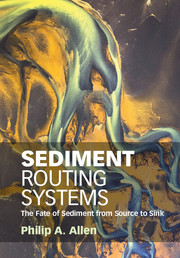Book contents
- Frontmatter
- Contents
- Preface
- Part I A Global View of Sediment Routing Systems
- Part II The Segments of Sediment Routing Systems
- Part III The Functioning of Sediment Routing Systems
- 7 Denudation and Sedimentation
- 8 Dynamics of Sediment Routing Systems
- Part IV The Stratigraphic Record of Sediment Routing Systems
- References
- Index
7 - Denudation and Sedimentation
from Part III - The Functioning of Sediment Routing Systems
Published online by Cambridge University Press: 03 October 2017
- Frontmatter
- Contents
- Preface
- Part I A Global View of Sediment Routing Systems
- Part II The Segments of Sediment Routing Systems
- Part III The Functioning of Sediment Routing Systems
- 7 Denudation and Sedimentation
- 8 Dynamics of Sediment Routing Systems
- Part IV The Stratigraphic Record of Sediment Routing Systems
- References
- Index
Summary
Range of Techniques
The denudation of continental landscapes varies spatially from individual hillslopes to vast drainage basins, and temporally from the scale of individual sediment transport events to the growth and decay of mountain belts. There are consequently many techniques available to capture aspects of the fluxes, budgets and rates of sedimentation and denudation of sediment routing systems, chief of which are the measurement of suspended loads at river gauging stations, dams and reservoirs, the estimation of sediment volumes in the depositional part of sediment routing systems, the use of thermochronometers such as (U-Th)/He diffusion, fission track analysis and other short half-life isotopic systems, and cosmogenic radionuclide analysis.
In present-day sediment routing systems, denudation can be assessed from the fluxes of particulate and dissolved matter measured in the rivers draining certain source areas (Section 2.3). A common approach is to measure suspended sediment loads using historic records (Milliman and Syvitski, 1992; Summerfield and Hulton, 1994; Syvitski and Morehead, 1999; Syvitski et al., 2003, 2005; Syvitski and Milliman, 2007; Milliman and Farnsworth, 2011). Historic records from gauging stations are prone to a number of biases: sediment fluxes may be strongly affected by anthropogenic influences (Syvitski et al., 2005; Wilkinson and McElroy, 2007), may fail to register large magnitude-low frequency events that dominate long-term behaviour, and neglect mass transport as bedload (Turowski, Rickenmann, and Dadson, 2010) and as solute load (Meybeck, 1976). Shortperiod historic measurements from gauging stations may not, therefore, be representative of longer timescales.
Whereas suspended sediment loads have been measured at gauging stations, commonly at intervals of several days, in some countries for more than a century, cosmogenic radionuclides reveal catchment-averaged denudation rates at timescales of 102−105 years (von Blanckenburg, 2005) (Section 7.6). Cosmogenic radionuclides, such as 10Be and 26Al, are produced in situ by the bombardment of cosmic rays. Since cosmic rays penetrate a certain distance into a host rock, slower denudation results in longer exposure and vice versa. In this way, the erosion rate of static individual boulders can be analysed. However, spatially averaged denudation rates can be evaluated by taking samples from the bedload of streams, which has the effect of averaging denudation over the contributing drainage area for the stream (Brown et al., 1995; Bierman and Steig, 1996; Granger, Kirchner, and Finkel, 1996).
- Type
- Chapter
- Information
- Sediment Routing SystemsThe Fate of Sediment from Source to Sink, pp. 193 - 239Publisher: Cambridge University PressPrint publication year: 2017

